The first link between the M113 and Bradley
Early genesis: From APC to ICV
WW2 experience that that there was plenty of improvement on the concept of armored warfare. Infantry was generally separated from and already problems seen in WW1 when armor outrace the infantry, and was left alone to fend off ...other infantry showed the need for combined arms, both elements protecting each others, the tank bringing the invulnerable strongpoint-cleaner for the infantry while the latter guarded the first, with its better awareness of the fighting environment, from enemy infantry armed with anti-tank weapons.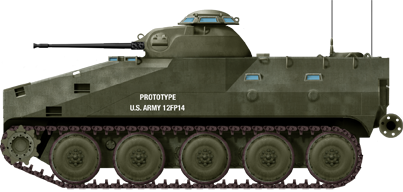
This doctrine was better refined especially in late war urban combat in Germany and in the Pacific. Only Germany had thought it through and provided its Panzerdivision and organic infantry, the panzergrenadiere, complete with their own half-tracks to keep pace. The need for specialist vehicles maintaining infantry always in close contact with friendly armor became and evidence. If the allies already had half-tracks such as the M3s, they still lacked the protection offered to tanks. The Red Army resorted to tank ride or "tank desant" in a hazardous way while Canada converted headless tanks into "Kangaroos". More than the others, the Kangaroo pointed the way forward with indeed a much better armor and same traction. Obviously these conversions were not tailored for the job, but specific APC (Armored Perosnal Carrier) designs, fully-tracked, were already worked out in 1944.
The post-war lineage started with the massive M44, the M75 and M59 and until the well-rounded, aluminium hulled M113, which quickly became the standard US, NATO and allied tracked APC. As Fully tracked vehicles used as armored personnel carrier apparead, their tracks provoked still a lot of friction and like tanks, they suffered in terms of range and speed on hard surfaces. Therefore, as the Soviet Block did, wheeled vehicles with off-road caracteristics soon became a must in addition or complement. And still, they offered a limited protection, not being thrown directly into the fighting and thus failing to the infantry in close proximity with armor: They had to offload infantry which had to catch up, while the vehicles folded down, earning the "battlefield taxis" nickname.
A serie of manoeuvers with these early generation APCs had this vehicle type quesitoned for its true effectiveness. Germany for example rejected the APC in its originakl form and went directly for the Schützenpanzer Lang HS.30, which became the first infantry fighting vehicle (IFV), soon to be imitated behind the iron curtain by the BMP-1. For a non-specialized eye, these vehicles still looks suspiciously like "tanks". But the IFV as a concept, tried to reconcile both world. Better armed and protected, even if this cost some troop carrying capacity, these vehicles were far better suited for their role close to the armor.
In that case, the infantry section could stay all along in the vehicle and fight alongside the tanks, notably to search and destroy enemy infantry armed with anti-tank means. The fully enclosed mode was also compatible with new concepts of NBC warfare, operating on chemical and nuclear-contaminated terrain where an exposed infantry would not survive. Military theorists that were following that trend in the mid 1960s were quick to point out the arrival of the BMP, answered in turn by the German IFV Marder. And all of this happened as the production of the M113, just started, was questioned back in the US for these new developments.
Start of the program: MICV-65
The M113 armored personal carrier was just being produced when in August 1963, the United States and Federal Republic of Germany signed an agreement to develop a new common main battle tank. The MBT70 was stated to reach very high performance, notably through speed, that would be just way too much for the M113 to follow. By 1963 in "A Study of Alternatives for a Post 1965 Infantry Combat Vehicle" a new high performance mechanized infantry combat vehicle, soon known in military circles as MICV was advocated to serve alongside the new upcoming main battle tank.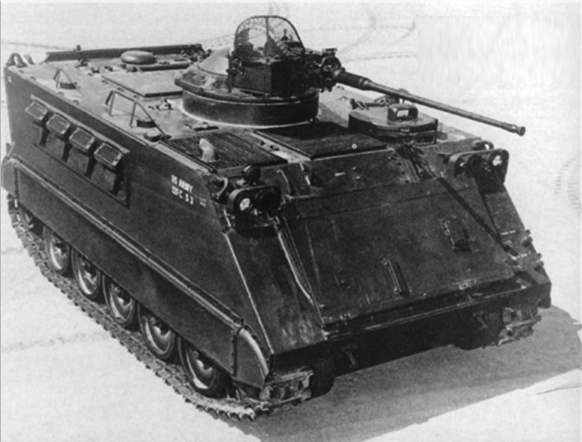
XM-734
At the same time, the US Army Infantry School at Fort Benning started exploring the new Ifnatry Combat Vehicle concept by itself, with just infantry stying in the infantry section on benches and facing in towards the center, then relocating to the middle and sitting back-to-back to face out, and then cutting out rifle ports into the walls, then adding vision slots and test the fire on the move concept. This culminating with the XM734, a modified M113 with a centrally mounted one-man enclosed gun cupola for two heavy MGs, with options for recoiless rifle, extra pintles for machine guns firing through top hatch. The firepower was completely demultiplicated compared to the basic M113. It was soon integrated into the new MICV-65 program.
The programme behind MICV-65 was what we would call today the first US "Infantry Fighting Vehicle" or IFV but called at that time "Infantry Combat Vehicle" (ICV), mererly a play with words. From this program emerged two proposals:
-One from Pacific Car and Foundry, the XM701, based on the M110 self-propelled artillery chassis
-One from FMC (productin the M113) with a much-improved model called the XM734.
However due to the more radical nature of the approach, the XM701 was selected for further work.
It led to a requirement for a lighter scout vehicle emerging at the same time, and this time leading to the XM800 Armored Reconnaissance Scout Vehicle, with two studied, one tracked and one wheeled. They both shared the same turret, armed with the new M139 20 mm autocannon inspired by the German HS.30 and essentially a licensed version of the Hispano-Suiza HS.820. This turret made its way on the XM-700.
Keeping pace with the MTB-70
While the MTB-70 advanced slowly but surely going through its long list of pre-requirements negociated with Germany, the new MICV-70 program was started, but prospects in 1964 were for it to need a full decade worth of development, while the new MBT, which had full priority, was likely to be ready sooner. So in the meantime, the Combat Development Command looked for essentially an interim MICV, to be built before the adoption of the MICV-70.This MICV-65 was approved in March 1964. By June the same year, a contract was awarded to Pacific Car and Foundry. It was tasked of the design and fabrication of a prototype, plus five evaluation pilots of the MICV-65, but known in the army as the "Infantry Combat Vehicle XM701". Why we never heard about this interim M701 Infantry Fighting Vehicle ? This is the object of the current, very long and protracted development of the M2 Bradley, the ultimate realization of the MICV-70. And the XM-701 was the first step on this long road.
Pacific Car & Foundry's take on the MICV
Unlike the appearance suggests, the XM-701 just a modification of the M113. To reach the desired high speed required to follow the new Main Battle Tank, setup to be capable of 70 kph+ the company started on an almost blank page. Instead of taking the M113 as a base for development, the smaller M107/M110 self-propelled gun was chosen. It was incidentally already produced by Pacific Car and Foundry. A reinforced aluminium body was built above it and a turret which could be fitted by either a 0.5 cal. heavy machine gun, or a 20mm cannon as required at the time in the specifications.The prototype was ready in record time, by May 1965. It was followed by the five pilot asked for. The prototype was registred 12FP14, and had significant differences with the five pilot vehicles (12FP15-12FP19). The mos recoignsable traits were the slanted nose, and differently shaped front section as well as the left side armor, location of the headlights (at the extreme edge). The pilot vehicles had a roomier, standard slab-sided nose and forward part. Pilot N°1, 2 and 3 had steel hulls, while Pilot N°4 and and 5 had aluminum alloy hulls, like the M113, to reclaim velocity.
Hull Design
The chassis of the M107/110 self propelled gun was small, but very sturdy not only to endure the excessive recoil force of the main gun it was supposed to carry, the large 175 mm (6.8 in) gun, it was found a perfect basis to adopt above it a relatively light hull structure, albeit not replocating the M113 one bit. It was smaller and with sloped sides, offering far less internal volume than the M113. It was not the point however. All in all, Combat loaded, the steel XM-701 weighted 54,050 pounds, the aluminum version 50,750 pounds.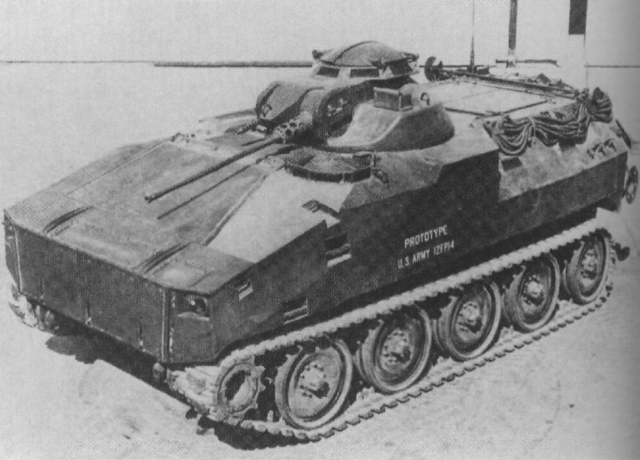
XM701 prototype as delivered As said above, wether the hull was made of steel or aluminium. It had the same outlook below the chassis, but the nose was relatively bulky, at least compared to the chassis, and still only housing the engine and transmission. The forward glacis depending of the version protytype or pilot, was shaped with a large flat surface, reclining only on the side of the forward left driver's position. The other side was asymetric. At the very front of the glacis was located a trim vane with its hinges, apparently bolted shut. On the pilots, the boxy extensions on the forward sides are cleary visible, made of two add-on bolted panels.
Immediately after started the combat section, with the turret located in the center, fitted with a periscopic cupola (more on this below), in a squarish center section but with another glacis at its base, meeting the nose plate. It's recess allowed the driver's hatch to lay down when fully opened. The nose itself was mostly flat with two slightly sloped outwards sides. The front plate had openings for the lights and the forward lifting hook, plus two more eyes welded and bolted on the lower chassis nose part, in between the drive sprockets. On the prototype, thes elights were located on the outer slopes of the forward nose.
The rear section is perhaps the most recoignisable aspect of the vehicle: Apart from a small section of around half a meter tall, the roof part is sloped to a 30° angle, over the troop small compartment. The whole back plate is sloped inwards, with a double door for access and exit. There was a provision for a fifth pistol port in the right door, apparently not used. There is no photo clearly showing the top pf the vehicle, but all shows a double hatch on top of the compartlent, hinged outwards. The very back receive hook eyes, various accessories and one or two antennae. The sloped sides shows two windows and pistol ports below, located on the flat part.
The XM-701 despite its small size, carried a 12-man crew: The commander and gunner both sharing the turret, the driver forward with his own hatch and three vision blocks (central M27 plus four M17 periscopes) while the cover was fitted for the M24 infrared periscope. And still, nine infantrymen were crammed into the rear compartment. For accesss and exit, outside the rear doors/ramp, driver's hatch, two-piece cupola hatch, opening outwards, the squad compartment also had two hatches.
Protection
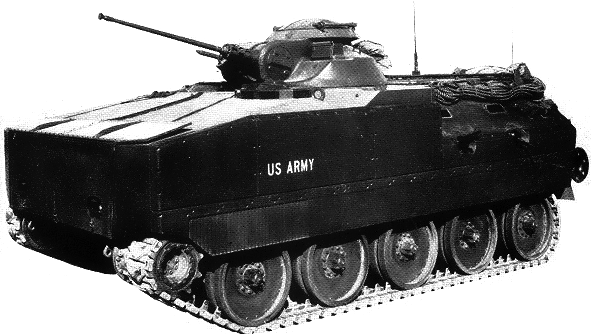
XM701 Pilot Protection-wise, the vehicle's armor thickness is not known with precision but according to specications, thick enough to survive similar or higher rounds impacts (23 mm guns). Made in RHA, either steel or aluminium, it was probably 20mm (0.8 in) on the forward section. The sloped sides at the rear only had a fraction of this thickness. Indeed specifications looked at the Soviet 23 mm cannon in development.
For collectve protection, as required, against NBC threats, the XM701 was fitted with the E51 NBC gas particulate filter unit. It was just an adaptation of the collective protection designed for the MBT70. Classic now, but revolutionary at the time, it included a tight sealing of the entire vehicle, and a pressurization system. Any gaz entering the vehicle was likely to be ousted, thus enabling combatants to not wear a mask while onboard.
Turret and armament
The turret was made in cast steel armor on all pilots. It was hydraulically operated, two man, armed with a 20mm Ml 39 gun on one side, and a 7.62mm M73 coaxial machine gun on the other. The M73 was essentally a modified M60 for tank use. But the XM-701 also included two more 7.62mm M60 machine guns in their own pisitions plus the five 7.62mm M14 rifles at the rea, four in the side pistol ports and one in the rear door, but in total there were seven firing stations for the squad compartment alone. Vision blocks were complemented by M27 periscope in the hull roof, above the ramp firing station.Pilots N°1 and 4 for comparative tests had ball mounts installed for M14 rifles the remainder other had standard firing ports. The M60 machine guns were activated by the driver through ball mounts. The commander had a 360 degree view thanks to the eight vision blocks around the turret separate top, while the gunner was provided the M34C periscope. The main M139 20 mm autocannon derived from the post-WW2, 1000 rpm AA gun HS.820 was a formidable AA gun also adopted by the Bundeswehr for its armored vehicles. Essentially the same gun mechanically (as a Gas unlocked, delayed blowback feed) it had the same performances, 1000 round/min, 1,050 m/s (3,400 ft/s) muzzle velocity and effective range of 1,500 m (4,900 ft). With the addition of the many firing ports and stations for practically every personal anboard, this made for an amazing firepower, head and shoulders above any APC.
Powerplant and performances
The XM701 was powered by an 8V71T diesel engine. It was coupled with an Allison XTG-411-2A transmission, and with the turbocharger, it developed 425 horsepower at 2,300 rpm, enough for 60+ kph. Like the original chassis, it had front drive sprockets and five standard roadwheels, the last acting as tensioners and trailing idlers. They rested on torsion bar suspension. The tracks were 15 inch wide, with the standard double pin model. The XM-701 was amphibious like the M113, and apparently still buoyant enough to float, also helped by a better sealing. The engine compartment was completely sealed, water from the outside cooling the engine, bilge pumps activated and the trim vane erected.Interestingly there was an auxiliary power unit (APU) was installed in the engine compartment, starting the engine by cold weather, resupplying the batteries and maintaining the vehicle operational when cold. The XM-701 was specified to operated for 24 hours in buttoned-up, full NBC conditions; So a stove and toilet were included for the crew. Space restrictions eliminated the winch replaced by two capstans stowed at the rear-left, to be attached to the drive sprockets when in use. The cabled were two 150 foot length, nylon-stell strapped and secured over the squad compartment, to be combined with the capstans for unditching.
Fate
Nothing came out from the XM-701 from Canadian Car and Foundry, although it was one of the earliest attempt to devise a fully-fledged IFV in the US. The prototypes were delivered in early 1965, but after a grualling serie of tests, proved to be a disappointment. Firts off the Hispano Suiza 20-mm cannon was unstabilized and hardly accurate, and practical fire on the move for the ten infantrymen was problematic for the same reasons. At the end of the field testing, the Army rejected the XM701 as too large, slow, and heavy, so closer to the M44 APC in that way.The MICV-65 program was eventually terminated, but still ready as a "back up". The MICV-70 program went up to the final M2 Bradley with sixteen years to materlize. The intermediate was the XM723 prototype built for revised MICV project, interwoven with Packard and Chrysler proposals during the RFP phase of this revised project made the original specifications for the XM-701 essentially obsolete, one crucial point for procurement. A large part of this was due to the appearance of the BMP-1.
In 1966-1967, as the Vietnam War intensified, Cornell Aeronautical Laboratory conducted studies under Army contract, the first released in June for a cost effectiveness analysis of the MICV-70, concluded it was to be still full-tracked, but with aluminum armor and with a larger turret, this tipme a stabilized cannon, and a crew of twelve men. The second study one year later considered to add a TOW in place of the proposed cannon and concluded an organic TOW MICV would be ideal as complement. However, the Soviet BMP-1 making its public debut on Red Square, in May 1967, had not only a 73 mm cannon, far more potent even though low-velocity, combined to a small ATGM, combined with NBC proof, better armour design, low profile and still great speed. It just ramped up the debate and forced to a new set of specifications for the MICV programme, based on the 1968 Colonel Casey's report.
XM 701 MICV specifications | |
| Dimensions | Unknown |
| Total weight, battle ready | 50,750 - 54,050 Ibs (25 tons) |
| Crew | 12 (Driver, Gunner, Commander, 9 infantry) |
| Propulsion | CCF 8V71T diesel engine |
| Suspension | Torsion bars |
| Speed (road) | 60 km/h (40 mph) |
| Range | Unknown |
| Armament | 20 mm Autocannon, 12 MGs |
| Armor | 20 mm RHA, steel/aluminium |
| Total production | 6 in 1965 |
Illustrations
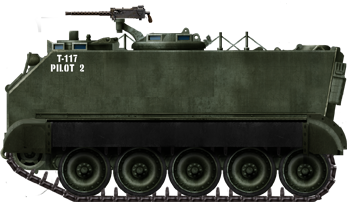
The T117 prototype APC, which shared many similarities.

First prototype, with its slanted nose
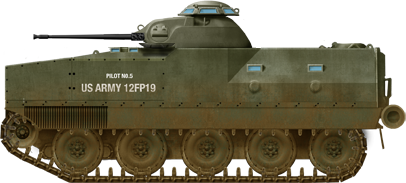
The bulkier Pilot N°5
Photos

XM701 prototype as delivered

XM701 Pilot

XM734
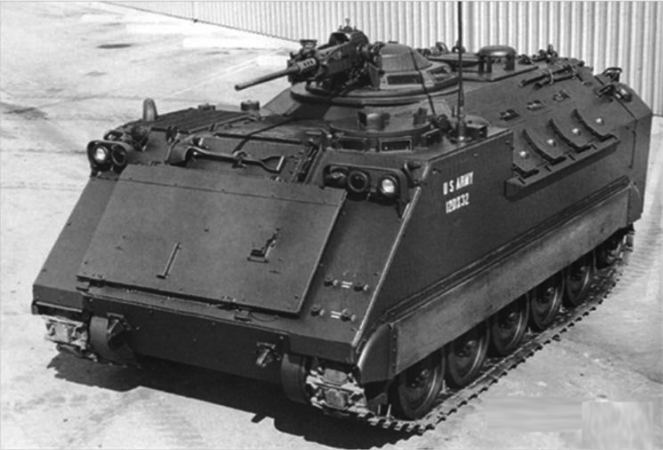
XM765
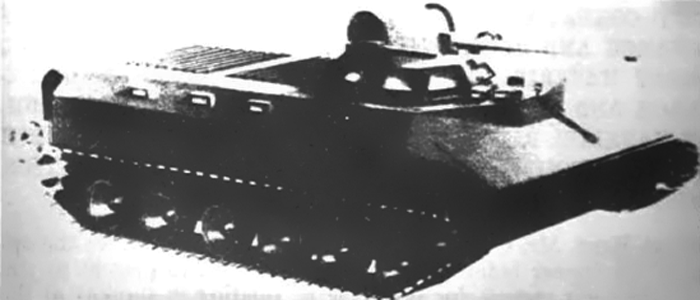
MICV 70 artist conception 1972
More
Books
Zaloga, Steven and Sarson, Peter. M2 / M3 Bradley Infantry Fighting Vehicle 1983 - 1995, Osprey (UK) Ltd, 1995, London, New Vanguard Series No. 18.Links
3. Integrating Dismounted Infantry Capabilities with Combat Vehicles - JSTOROn russian-tanks.com
M701 on globalsecurity.org
On btvtinfo.blogspot.com
Full development on historyofwar.org
RAND report: "Understanding Why a Ground Combat Vehicle That Carries Nine Dismounts Is Important to the Army"

Cold War Tanks


































Cold war tanks posters

Cold War Main Battle Tanks

Cold War Soviet Army
Museums, Movies, Books & Games
The Tanks and Armor in pop culture
Tanks and armored vehicles in general are only really grasped when seen first person: The mass, the scale, it's all there. Explore also the way tanks were covered in the movie industry, in books and in video games.Movies:
Best tanks movie on warhistoryonline.com
On imdb.com
On bestsimilar.com/
miltours.com
liveabout.com/
watchmojo.com
Video Games:
pcgamesn.com
historyhit.com
levvvel.com
vg247.com/best-tank-games
mmobomb.com/
alienwarearena.com

